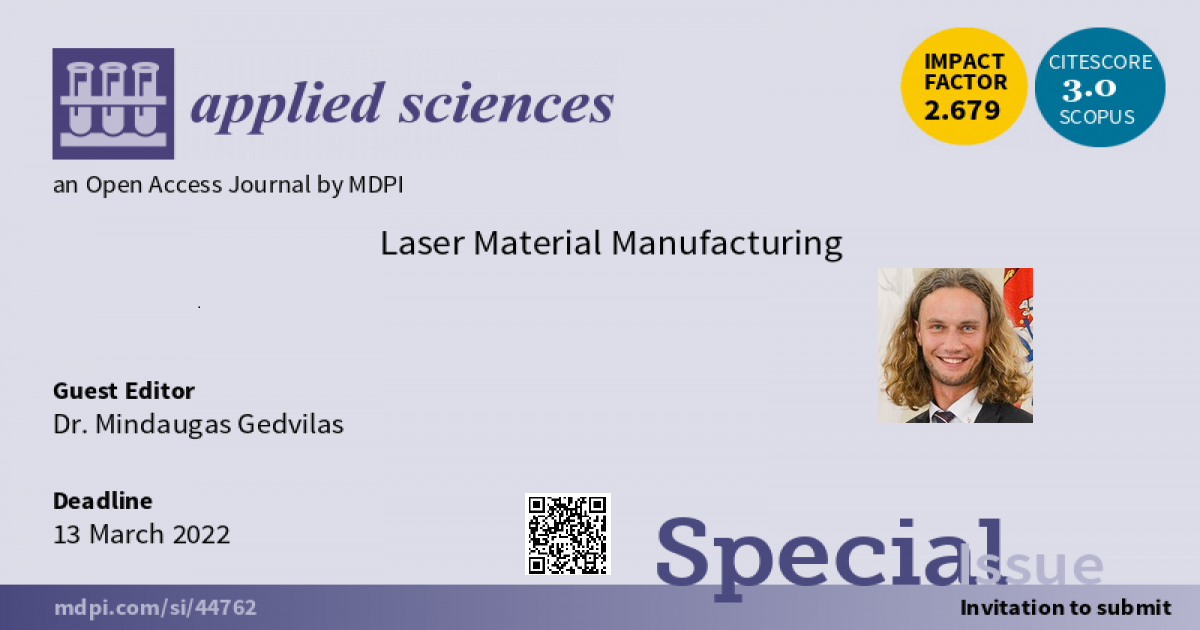Laser Material Manufacturing
A special issue of Applied Sciences (ISSN 2076-3417). This special issue belongs to the section "Optics and Lasers".
Deadline for manuscript submissions: closed (13 March 2022) | Viewed by 12643

Special Issue Editor
Interests: efficient laser ablation; two-color double-pulse irradiation; burst-mode; heat transfer in laser–matter interaction; stealth dicing; laser interference ablation; laser formation of bio-inspired functional surfaces; laser-induced periodical surface structuring (LIPSS); ripple formation; multilayer thin-film solar cell interaction with laser irradiation.
Special Issues, Collections and Topics in MDPI journals
Special Issue Information
Dear Colleagues,
This Special Issue of Applied Sciences "Laser Material Manufacturing" seeks to promote scientific and technological research from all aspects of manufacturing and material processing using ultrafast lasers, starting from basic research, to applied science, and engineering investigations. This Special Issue will publish research works concerning novel investigations and science advances connected to precision laser fabrication, laser milling technology, efficient laser ablation, bio-inspired structuring of functionalized surfaces, cold ablation, direct laser interference patterning, stealth dicing, thin-film patterning, burst mode irradiation, ablation-cooled material removal, laser coloring, and laser-induced periodical surface structuring (LIPSS).
This Special Issue will publish all types of papers: communications, articles, and reviews. The standards for submissions are of high-quality, impact, and novelty. The papers must be interesting for a wide audience in all fields of science, technology, and medicine.
Applied Sciences journal is an open access, peer-reviewed, and online-only journal publish by MDPI.
Dr. Mindaugas Gedvilas
Guest Editor
Manuscript Submission Information
Manuscripts should be submitted online at www.mdpi.com by registering and logging in to this website. Once you are registered, click here to go to the submission form. Manuscripts can be submitted until the deadline. All submissions that pass pre-check are peer-reviewed. Accepted papers will be published continuously in the journal (as soon as accepted) and will be listed together on the special issue website. Research articles, review articles as well as short communications are invited. For planned papers, a title and short abstract (about 100 words) can be sent to the Editorial Office for announcement on this website.
Submitted manuscripts should not have been published previously, nor be under consideration for publication elsewhere (except conference proceedings papers). All manuscripts are thoroughly refereed through a single-blind peer-review process. A guide for authors and other relevant information for submission of manuscripts is available on the Instructions for Authors page. Applied Sciences is an international peer-reviewed open access semimonthly journal published by MDPI.
Please visit the Instructions for Authors page before submitting a manuscript. The Article Processing Charge (APC) for publication in this open access journal is 2400 CHF (Swiss Francs). Submitted papers should be well formatted and use good English. Authors may use MDPI's English editing service prior to publication or during author revisions.
Keywords
- ultrashort pulses
- efficient ablation
- burst mode
- cold ablation
- precision fabrication
- laser coloring.
Benefits of Publishing in a Special Issue
- Ease of navigation: Grouping papers by topic helps scholars navigate broad scope journals more efficiently.
- Greater discoverability: Special Issues support the reach and impact of scientific research. Articles in Special Issues are more discoverable and cited more frequently.
- Expansion of research network: Special Issues facilitate connections among authors, fostering scientific collaborations.
- External promotion: Articles in Special Issues are often promoted through the journal's social media, increasing their visibility.
- e-Book format: Special Issues with more than 10 articles can be published as dedicated e-books, ensuring wide and rapid dissemination.
Further information on MDPI's Special Issue policies can be found here.





